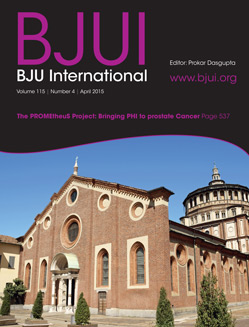
Editorial: A urologists’ guide to the multi-parametric magnetic resonance imaging (mpMRI)-galaxy
The rise of multi-parametric MRI (mpMRI) for the assessment of patients with suspicion of prostate cancer has led to an enormous shift in the practice of every urologist dealing with frontline diagnostics [1].
At the same time, researchers and industry have identified acres of fruitful soil to place the seeds of their respective interests, sometimes in collaboration with each other producing valuable contributions to this shift in practice, sometimes taking benefits by merely assimilating…

Video: Is a 12-core biopsy still necessary in addition to a targeted biopsy?
In patients with a previous negative prostate biopsy and a suspicious lesion on magnetic resonance imaging, is a 12-core biopsy still necessary in addition to a targeted biopsy?
Simpa S. Salami*, Eran Ben-Levi†, Oksana Yaskiv‡, Laura Ryniker*, Baris Turkbey§, Louis R. Kavoussi*, Robert Villani† and Ardeshir R. Rastinehad*†
*The Arthur Smith Institute for Urology, †Department of Diagnostic and Interventional Radiology, and ‡Department of Pathology, Hofstra North Shore-LIJ…

Article of the Week: Minimum five-year follow-up of 1,138 consecutive laparoscopic radical prostatectomies
1 Comment
/
Every week the Editor-in-Chief selects the Article of the Week from the current issue of BJUI. The abstract is reproduced below and you can click on the button to read the full article, which is freely available to all readers for at least 30 days from the time of this post.
In addition to the article itself, there is an accompanying editorial written by a prominent member of the urological community. This blog is intended to provoke comment and discussion and we invite you to use the comment…

Editorial: The need for standardised reporting of complications
In the context of diversifying practice models, implementation of new technologies such as the Da Vinci surgical robot and rising healthcare costs, there is growing interest in evaluating the quality of surgical work. This extends into health policy, as reimbursement penalties are introduced for ‘inappropriate’ outcomes (e.g. excessive readmissions). Consequently, there is a significant need to provide an accurate assessment of complications and mortality when reporting on surgical outcomes.
Despite…

Video: 1,138 consecutive laparoscopic radical prostatectomies – Minimum five-year follow-up
Minimum five-year follow-up of 1,138 consecutive laparoscopic radical prostatectomies
Ricardo Soares, Antonina Di Benedetto, Zach Dovey, Simon Bott*, Roy G. McGregor† and Christopher G. Eden
Department of Urology, Royal Surrey County Hospital, Guildford, *Department of Urology, Frimley Park Hospital, Frimley, Surrey, UK, and †Cornwall Regional Hospital, Montego Bay, Jamaica
OBJECTIVES
To investigate the long-term outcomes of laparoscopic radical prostatectomy…

Article of the Month: The PROMEtheuS Project: Bringing PHI to prostate Cancer
Every week the Editor-in-Chief selects the Article of the Week from the current issue of BJUI. The abstract is reproduced below and you can click on the button to read the full article, which is freely available to all readers for at least 30 days from the time of this post.
In addition to the article itself, there is an accompanying editorial written by a prominent member of the urological community. This blog is intended to provoke comment and discussion and we invite you to use the comment…

Editorial: Time to replace PSA with the PHI?
Yet more evidence that the PHI consistently outperforms PSA across diverse populations
The Prostate Health Index (PHI) has regulatory approval in >50 countries worldwide and is now being incorporated into prostate cancer guidelines; for example, the 2014 National Comprehensive Cancer Network Guidelines for early prostate cancer detection discuss the PHI as a means to improve specificity, using a threshold score of 35 [1]. The PHI is also discussed in the Melbourne Consensus Statement [2], and…

Video: Clinical performance of PHI for prediction of prostate cancer: data from the PROMEtheuS project
Clinical performance of Prostate Health Index (PHI) for prediction of prostate cancer in obese men: data from a multicenter European prospective study, PROMEtheuS project
Alberto Abrate, Massimo Lazzeri, Giovanni Lughezzani, Nicolòmaria Buffi, Vittorio Bini*,Alexander Haese†, Alexandre de la Taille‡, Thomas McNicholas§, Joan Palou Redorta¶,Giulio M. Gadda, Giuliana Lista, Ella Kinzikeeva, Nicola Fossati, Alessandro Larcher,Paolo Dell'Oglio, Francesco Mistretta, Massimo Freschi** and Giorgio…

Article of the Week: Co-administration of TRPV4 and TRPV1 antagonists potentiate the effect of each drug
Every week the Editor-in-Chief selects the Article of the Week from the current issue of BJUI. The abstract is reproduced below and you can click on the button to read the full article, which is freely available to all readers for at least 30 days from the time of this post.
In addition to the article itself, there is an accompanying editorial written by a prominent member of the urological community. This blog is intended to provoke comment and discussion and we invite you to use the comment…

Editorial: How much potential for Transient Receptor Potential channels in the bladder?
In this issue of the BJUI, Charrua et al. [1] report on the possible interaction of two members of the vanilloid subfamily of transient receptor potential (TRP) channels in the control of rat urinary bladder function, TRPV1 and TRPV4. TRP channels are a family of cation-selective channels with 28 known mammalian members. Six of them belong to the subfamily of vanilloid receptors (TRPV channels) and fall into four groups, TRPV1/TRPV2, TRPV3, TRPV4, and TRPV5/TRPV6. The physiological and pharmacological…
